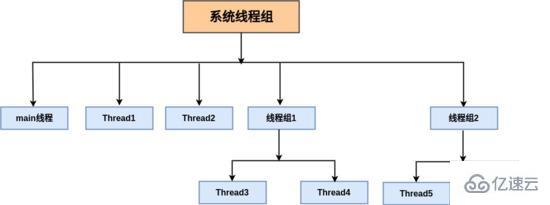使用线程组在Java中实现线程管理
来源:亿速云
时间:2024-01-30 10:02:14 466浏览 收藏
从现在开始,我们要努力学习啦!今天我给大家带来《使用线程组在Java中实现线程管理》,感兴趣的朋友请继续看下去吧!下文中的内容我们主要会涉及到等等知识点,如果在阅读本文过程中有遇到不清楚的地方,欢迎留言呀!我们一起讨论,一起学习!
Java中线程组(ThreadGroup类)
Java中使用ThreadGroup类来代表线程组,表示一组线程的集合,可以对一批线程和线程组进行管理。可以把线程归属到某一个线程组中,线程组中可以有线程对象,也可以有线程组,组中还可以有线程,这样的组织结构有点类似于树的形式,如图所示。

用户创建的所有线程都属于指定线程组,如果没有显式指定属于哪个线程组,那么该线程就属于默认线程组(即main线程组)。默认情况下,子线程和父线程处于同一个线程组。
此外,只有在创建线程时才能指定其所在的线程组,线程运行中途不能改变它所属的线程组,也就是说线程一旦指定所在的线程组就不能改变。
二.为什么要使用线程组
1.安全
同一个线程组的线程是可以相互修改对方的数据的。但如果在不同的线程组中,那么就不能“跨线程组”修改数据,可以从一定程度上保证数据安全。
2.批量管理
可以批量管理线程或线程组对象,有效地对线程或线程组对象进行组织或控制。
三.线程组使用示例
1.线程关联线程组:一级关联
所谓一级关联就是父对象中有子对象,但并不创建孙对象。比如创建一个线程组,然后将创建的线程归属到该组中,从而对这些线程进行有效的管理。代码示例如下:
public class ThreadGroupTest {
public static void main(String[] args) {
ThreadGroup rootThreadGroup = new ThreadGroup("root线程组");
Thread thread0 = new Thread(rootThreadGroup, new MRunnable(), "线程A");
Thread thread1 = new Thread(rootThreadGroup, new MRunnable(), "线程B");
thread0.start();
thread1.start();
}
}
class MRunnable implements Runnable {
@Override
public void run() {
while (!Thread.currentThread().isInterrupted()) {
System.out.println("线程名: " + Thread.currentThread().getName()
+ ", 所在线程组: " + Thread.currentThread().getThreadGroup().getName()) ;
try {
Thread.sleep(1000);
} catch (InterruptedException e) {
e.printStackTrace();
}
}
}
}
复制代码执行结果如下:
线程名: 线程A, 所在线程组: root线程组 线程名: 线程B, 所在线程组: root线程组 复制代码
2.线程关联线程组:多级关联
所谓的多级关联就是父对象中有子对象,子对象中再创建孙对象也就出现了子孙的效果了。比如使用下图第二个构造方法,将子线程组归属到某个线程组,再将创建的线程归属到子线程组,这样就会有线程树的效果了。

代码示例如下:
public class ThreadGroupTest {
public static void main(String[] args) {
ThreadGroup rootThreadGroup = new ThreadGroup("root线程组");
Thread thread0 = new Thread(rootThreadGroup, new MRunnable(), "线程A");
Thread thread1 = new Thread(rootThreadGroup, new MRunnable(), "线程B");
thread0.start();
thread1.start();
ThreadGroup threadGroup1 = new ThreadGroup(rootThreadGroup, "子线程组");
Thread thread2 = new Thread(threadGroup1, new MRunnable(), "线程C");
Thread thread3 = new Thread(threadGroup1, new MRunnable(), "线程D");
thread2.start();
thread3.start();
}
}
class MRunnable implements Runnable {
@Override
public void run() {
while (!Thread.currentThread().isInterrupted()) {
System.out.println("线程名: " + Thread.currentThread().getName()
+ ", 所在线程组: " + Thread.currentThread().getThreadGroup().getName()
+ ", 父线程组: " + Thread.currentThread().getThreadGroup().getParent().getName());
try {
Thread.sleep(1000);
} catch (InterruptedException e) {
e.printStackTrace();
}
}
}
}
复制代码执行结果如下:
线程名: 线程A, 所在线程组: root线程组, 父线程组: main 线程名: 线程B, 所在线程组: root线程组, 父线程组: main 线程名: 线程C, 所在线程组: 子线程组, 父线程组: root线程组 线程名: 线程D, 所在线程组: 子线程组, 父线程组: root线程组 复制代码
3.批量管理组内线程
使用线程组自然是要对线程进行批量管理,比如可以批量中断组内线程,代码示例如下:
public class ThreadGroupTest {
public static void main(String[] args) {
ThreadGroup rootThreadGroup = new ThreadGroup("root线程组");
Thread thread0 = new Thread(rootThreadGroup, new MRunnable(), "线程A");
Thread thread1 = new Thread(rootThreadGroup, new MRunnable(), "线程B");
thread0.start();
thread1.start();
ThreadGroup threadGroup1 = new ThreadGroup(rootThreadGroup, "子线程组");
Thread thread2 = new Thread(threadGroup1, new MRunnable(), "线程C");
Thread thread3 = new Thread(threadGroup1, new MRunnable(), "线程D");
thread2.start();
thread3.start();
rootThreadGroup.interrupt();
System.out.println("批量中断组内线程");
}
}
class MRunnable implements Runnable {
@Override
public void run() {
while (!Thread.currentThread().isInterrupted()) {
System.out.println("线程名: " + Thread.currentThread().getName()
+ ", 所在线程组: " + Thread.currentThread().getThreadGroup().getName()
+ ", 父线程组: " + Thread.currentThread().getThreadGroup().getParent().getName());
try {
Thread.sleep(1000);
} catch (InterruptedException e) {
e.printStackTrace();
break;
}
}
System.out.println(Thread.currentThread().getName() + "执行结束");
}
}
复制代码执行结果如下:
线程名: 线程A, 所在线程组: root线程组, 父线程组: main 线程名: 线程B, 所在线程组: root线程组, 父线程组: main 线程名: 线程C, 所在线程组: 子线程组, 父线程组: root线程组 线程名: 线程D, 所在线程组: 子线程组, 父线程组: root线程组 批量中断组内线程 线程A执行结束 线程B执行结束 线程C执行结束 线程D执行结束 复制代码
今天带大家了解了的相关知识,希望对你有所帮助;关于文章的技术知识我们会一点点深入介绍,欢迎大家关注golang学习网公众号,一起学习编程~
-
501 收藏
-
501 收藏
-
501 收藏
-
501 收藏
-
501 收藏
-
403 收藏
-
397 收藏
-
357 收藏
-
158 收藏
-
486 收藏
-
459 收藏
-
296 收藏
-
491 收藏
-
208 收藏
-
356 收藏
-
437 收藏
-
427 收藏
-

- 前端进阶之JavaScript设计模式
- 设计模式是开发人员在软件开发过程中面临一般问题时的解决方案,代表了最佳的实践。本课程的主打内容包括JS常见设计模式以及具体应用场景,打造一站式知识长龙服务,适合有JS基础的同学学习。
- 立即学习 543次学习
-

- GO语言核心编程课程
- 本课程采用真实案例,全面具体可落地,从理论到实践,一步一步将GO核心编程技术、编程思想、底层实现融会贯通,使学习者贴近时代脉搏,做IT互联网时代的弄潮儿。
- 立即学习 516次学习
-

- 简单聊聊mysql8与网络通信
- 如有问题加微信:Le-studyg;在课程中,我们将首先介绍MySQL8的新特性,包括性能优化、安全增强、新数据类型等,帮助学生快速熟悉MySQL8的最新功能。接着,我们将深入解析MySQL的网络通信机制,包括协议、连接管理、数据传输等,让
- 立即学习 500次学习
-

- JavaScript正则表达式基础与实战
- 在任何一门编程语言中,正则表达式,都是一项重要的知识,它提供了高效的字符串匹配与捕获机制,可以极大的简化程序设计。
- 立即学习 487次学习
-

- 从零制作响应式网站—Grid布局
- 本系列教程将展示从零制作一个假想的网络科技公司官网,分为导航,轮播,关于我们,成功案例,服务流程,团队介绍,数据部分,公司动态,底部信息等内容区块。网站整体采用CSSGrid布局,支持响应式,有流畅过渡和展现动画。
- 立即学习 485次学习
